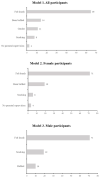Prevalence and Determinants of Depressive Symptoms among Young Adolescents in Malaysia: A Cross-Sectional Study
- PMID: 36670691
- PMCID: PMC9856963
- DOI: 10.3390/children10010141
Prevalence and Determinants of Depressive Symptoms among Young Adolescents in Malaysia: A Cross-Sectional Study
Abstract
Depression is the most common mental health problem affecting adolescents globally, wherein its increasing prevalence together with the negative health impacts escalates the need for further research in this area. This work determined the prevalence and factors associated with depressive symptoms among young adolescents in Malaysia. A total of 1350 adolescent aged 13 to 14 years in school across nine secondary schools in Selangor state, Malaysia participated in a cross-sectional study. Independent variables were examined using the using the Global School-Based Student Health Survey included age, gender, ethnicity, alcohol intake, smoking and illicit drug use, loneliness, bullying, parental marital status, income and supervision; and the Health Literacy and Stigma questionnaire examined mental health literacy levels. Depressive symptoms were the dependent variable which was examined using the Center for Epidemiology Study Depression (CESD) instrument. Prevalence of depressive symptoms among all participants was 19 % (95% CI [16.9, 21.2]), with a higher prevalence of depressive symptoms being reported among females 26.3% (95% CI [23.0, 29.8]) compared to males 11.7% (95% CI [9.4, 14.4]). Determinants namely females (AOR = 3.83; 95% CI [2.66, 5.52]), smoking (AOR = 6.16; 95% CI [3.15, 12.05]), been bullied (AOR = 3.70; 95% CI [2.51, 5.47]), felt lonely (AOR = 10.46; 95% CI [7.09, 15.42]) and having no parental supervision (AOR = 1.79; 95% CI [1.26, 2.53]) significantly increased the odds of depressive symptoms among all adolescents in the multivariate model. In addition, feeling lonely, being bullied and smoking were identified as common significant determinants of depressive symptoms across both genders. Feeling lonely (65% to 71%) and being bullied (10% to 19%) were ranked as the most important determinants of depressive symptoms among young adolescents. Tackling these factors would be instrumental in helping decision makers formulate depression prevention strategies and activities for adolescents.
Keywords: Malaysia; adolescents; depressive symptoms; determinants.
Conflict of interest statement
There are no conflict of interest, no competing financial interests and personal relationships to be declared by the authors for this study. The final version of the manuscript has been read and approved by all authors.
Figures
Similar articles
-
The Determinants of Mental Health Literacy among Young Adolescents in Malaysia.Int J Environ Res Public Health. 2022 Mar 9;19(6):3242. doi: 10.3390/ijerph19063242. Int J Environ Res Public Health. 2022. PMID: 35328930 Free PMC article.
-
Prevalence and correlates of depression among adolescents in Malaysia.Asia Pac J Public Health. 2014 Sep;26(5 Suppl):53S-62S. doi: 10.1177/1010539514544356. Epub 2014 Jul 28. Asia Pac J Public Health. 2014. PMID: 25070697
-
Prevalence and correlates of being bullied among adolescents in Indonesia: results from the 2015 Global School-based Student Health Survey.Int J Adolesc Med Health. 2019 Aug 6;34(1). doi: 10.1515/ijamh-2019-0064. Int J Adolesc Med Health. 2019. PMID: 31393832
-
Prevalence and correlates of being bullied among in-school adolescents in Malawi: results from the 2009 Global School-Based Health Survey.Malawi Med J. 2013 Mar;25(1):12-4. Malawi Med J. 2013. PMID: 23717749 Free PMC article.
-
Being Bullied Is Associated With Depression Among Malaysian Adolescents: Findings From a Cross-Sectional Study in Malaysia.Asia Pac J Public Health. 2019 Nov;31(8_suppl):30S-37S. doi: 10.1177/1010539519867796. Epub 2019 Aug 12. Asia Pac J Public Health. 2019. PMID: 31402682
Cited by
-
Adolescent Life Satisfaction: Association with Psychological, School-Related, Religious and Socially Supportive Factors.Children (Basel). 2023 Jul 7;10(7):1176. doi: 10.3390/children10071176. Children (Basel). 2023. PMID: 37508673 Free PMC article.
-
Depressive symptoms and its associated factors among secondary school adolescents of Birtamod Municipality, Jhapa, Nepal.PLOS Glob Public Health. 2024 Jan 19;4(1):e0002826. doi: 10.1371/journal.pgph.0002826. eCollection 2024. PLOS Glob Public Health. 2024. PMID: 38241240 Free PMC article.
-
Prevalence and risk factors associated with psychological distress among children in Penang, Malaysia: A stratified multistage cluster study.MethodsX. 2024 Nov 22;13:103069. doi: 10.1016/j.mex.2024.103069. eCollection 2024 Dec. MethodsX. 2024. PMID: 39687598 Free PMC article.
-
Prevalence of anxiety and depression among university students in Southern Saudi Arabia based on a cross sectional survey.Sci Rep. 2025 May 3;15(1):15482. doi: 10.1038/s41598-025-00695-y. Sci Rep. 2025. PMID: 40319090 Free PMC article.
-
Is secondhand smoke exposure associated with depressive symptoms among secondary school students in Malaysia? Findings from a national school-based study.Tob Induc Dis. 2025 Mar 18;23. doi: 10.18332/tid/197278. eCollection 2025. Tob Induc Dis. 2025. PMID: 40104398 Free PMC article.
References
-
- UNICEF Adolescents. 2019. [(accessed on 15 June 2022)]. Available online: https://data.unicef.org/topic/adolescents/overview/
-
- World Health Organization Mental Health Status of Adolescents in South-East Asia: Evidence for Action. Reg. Off. South East Asia. 2017. [(accessed on 1 January 2018)]. pp. 1–84. Available online: http://www.who.int/iris/handle/10665/254982.
LinkOut - more resources
Full Text Sources


